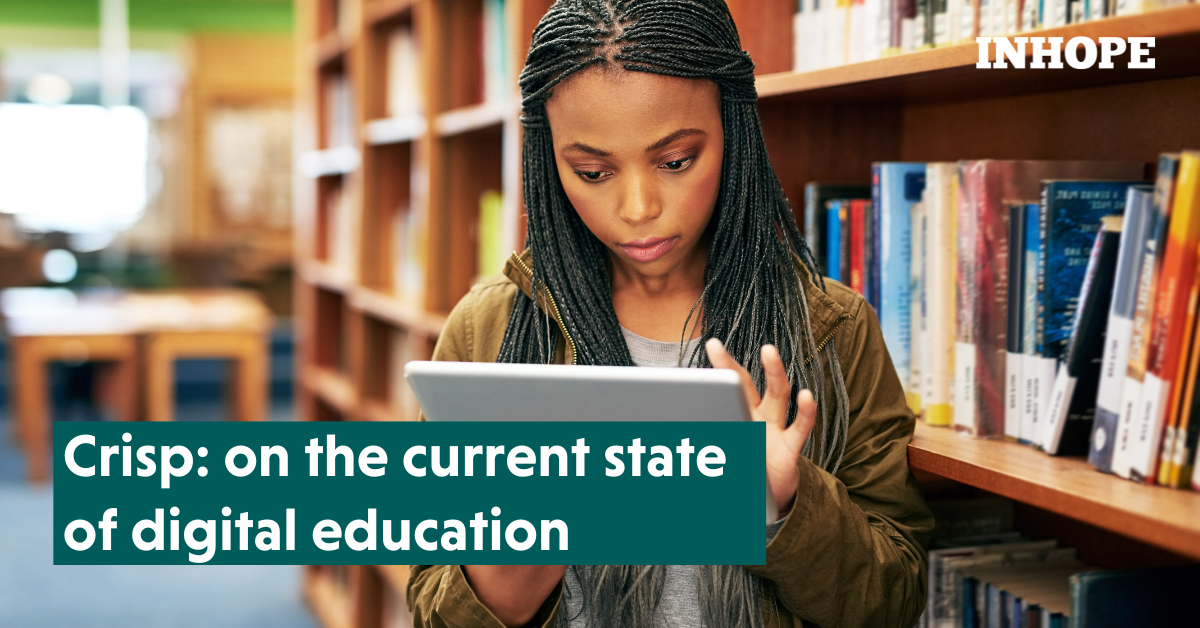Article
Partner Updates
Educational Articles
Crisp: on the current state of digital education
Digitalisation has become an integral part of our everyday lives. Whether in entertainment, socialisation, or education - the digital experience follows us everywhere we go. The start of the pandemic in the early months of 2020 has amplified this process and turned daily media use from a convenience into a necessity. We interviewed Anne Rana, Lead Threat Intelligence Analyst at Crisp - a trusted provider of Platform Risk Intelligence for global Trust and Safety teams - to find out how they view the current state of our digital education. What are gaps that need to be addressed and where do they see scope for potential?
A lot of energy has been invested into developing digital learning tools, but so far there has been a lack of importance placed on teaching kids how to navigate safely through online environments. Anne Rana explained that within the last couple of years we have seen a major shift in education: "We’ve seen kids transitioning from traditional institutional education to a much more hybrid form of education" – Anne Rana, Lead Threat Intelligence Analyst. This shift, has put a lot of ownership and responsibility on kids when it comes to handling their education.
Tasks that were previously taken on by teachers and educational systems were now placed in the hands of parents who are not necessarily equipped for the role. These changes have created a lot of new challenges for digital citizens. Parents are now more than ever responsible for their children’s safety online, but in most cases monitoring children's entire digital experience is unattainable. Due to this we must continuously work to create child-safe digital environments and encourage stakeholders to focus their attention on developing safe user experiences.
'Leveling up' in Digital Literacy
Thinking about new immersive technologies such as the metaverse also poses the question of increased risk. Will this new type of media create other or more dangerous threats? As Lead Threat Intelligence Analyst, Anne Rana determined that while the media landscape will become increasingly immersive, the threats will most likely remain similar to those we know. This is why Crisp thinks it is important now more than ever to develop fun and accessible ways for children to learn how to be safe online. Instead of focusing too much on platform-specific challenges, we need to work on facilitating safe digital habits for children. With AI technology that has been trained over 17 years to identify risk signals embedded within the digital chatter of bad actor groups, Crisp can anticipate the risks and need for intervention.
Utilising gamification is one of the potential ways of sharing knowledge with kids, Anne proposed. 'Gamifying' digital education by developing online reward systems through which children can 'level up' when they master online training tools, can be an accessible way to teach young children digital literacy. While the digital environment will always keep evolving, predatory behavior will most likely follow similar patterns, which kids can learn to be cautious of. Creating learning experiences that are fun and engaging can help to communicate this important content to a young audience.
Threats & Opportunities
The biggest gap Anne currently sees in our digital education is the lack of priority being placed on digital safety. "Many of the educational platforms are focused on providing a learning product, but not specifically focused on providing a safer user experience in the process." – Anne Rana, Lead Threat Intelligence Analyst. She emphasised that developing improved processes to safeguard children online is essential and will require stakeholder collaboration. Bringing together policymakers, parental groups, educational facilities, and tech companies is a big challenge, but Crisp also regards this as the biggest opportunity to collectively create something greater. Only by working together, and sharing knowledge, technologies, and experiences can we establish a safer digital experience for children.
Importance of Collaboration
The Lead Threat Intelligence Analyst at Crisp, stressed how essential collaborative efforts are in establishing safe digital spaces for children. To further expand their network in the fight for Child Digitial Safety, Crisp recently joined the World Economic Forum Global Coalition for Digital Safety. "At Crisp, we frequently collaborate with global partners, policymakers, Big Tech conventions, civil society, and NGOs by sharing over sixteen years of online safety expertise with them" - Anne Rana, Lead Threat Intelligence Analyst. Only through knowledge sharing, exchanging of resources, and developing combined solutions can we achieve the best possible outcome.
Crisp is a founding member of the Online Industry Safety Association and WeProtect Global Alliance, providing vital research to its annual Global Threat Assessment, and a proud member of INHOPE. Crisp contributes to the safe, daily online experiences of over two billion users, including an estimated 450 million children. Learn more at crispthinking.com.

Bringing together policymakers, parental groups, educational facilities, and tech companies is a big challenge, but Crisp also regards this as the biggest opportunity to collectively create something greater.
'